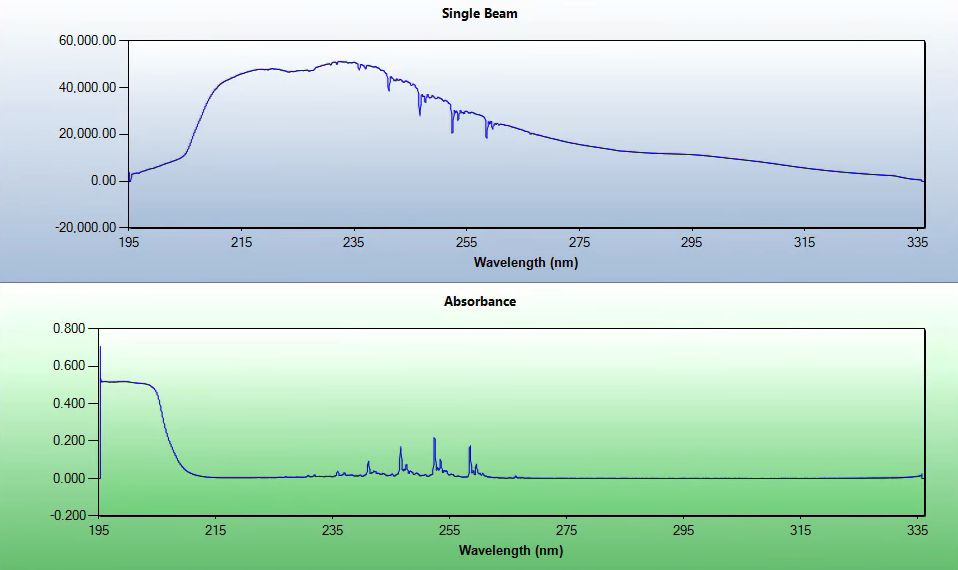Cerex UV Sentry
The Cerex UV SENTRY is an open-path gas analyzer that specializes in sensitive detection of key hazardous emissions such as Benzene and Chlorine over 1000+ meters of fence-line paths.
It sets the industry standard for time-resolved, gap-less fugitive emissions and chemical emergency monitoring.
As the most cost-effective solution for part-per-trillion detection limits of Benzene-specific monitoring, the UV SENTRY is deployed world-wide by some of the world’s largest petrochemical companies, oil refineries, and government agencies.
Key Features
- Benzene and other gases down to parts-per-trillion minimum detection limits (gas specific) within seconds – real-time data output
- Low cost of ownership, no-maintenance design; only consumables are dust filters and UV lamp
- Simple, inherent calibration verification using built-in flow cell
- Raw data auto-archived in .csv format for instant analysis, compared to “black box” solutions
- Remote control over network or internet – cellular-ready

Cerex UV Sentry
The Cerex UV SENTRY is an open-path gas analyzer that specializes in sensitive detection of key hazardous emissions such as Benzene and Chlorine over 1000+ meters of fence-line paths. It sets the industry standard for time-resolved, gap-less fugitive emissions and chemical emergency monitoring across fence lines, around process units, and around tank farms.
As the most cost-effective solution for part-per-trillion detection limits of Benzene-specific monitoring, the UV SENTRY is deployed world-wide by some of the world’s largest petrochemical companies, oil refineries, and government agencies.
Key Features
- Benzene and other gases down to parts-per-trillion minimum detection limits (gas specific) within seconds – real-time data output
- Low cost of ownership, no-maintenance design; only consumables are dust filters and UV lamp
- Simple, inherent calibration verification using built-in flow cell
- Raw data auto-archived in .csv format for instant analysis, compared to “black box” solutions
- Remote control over network or internet – cellular-ready

Standard
Weight 24.04kg (53lbs)
Enclosure type 4X – IP54, thermoelectrically cooled
Measurements
The UV Sentry is a parts per billion (ppb) to percent level chemical detection and quantification open-path UV-DOAS analyzer. It offers high-performing, time-resolved monitoring of a variety of regulated gases.
Operating Conditions
- Temperature -40°F to 131°F (-40°C to 55°C)
- Suitable for corrosive environment system deployment
- Tripod mountable for semi-permanent installations
- We recommend sheltering against wind and solar loading for permanent installations
Maintenance
- Lamp replacement time is application specific (2000 hour guaranteed half-life)
- Recommend monthly inspections of lamp, air filter and fans
- Rinse air conditioner fins as needed
- Fans are rated to 40,000 hours at 40°C

Harsh Climate
Based on years of the success with UV SENTRY, the Harsh Climate model was developed by Cerex’s engineers to meet the demand of open path analyzers that can output reliable data in the midst of extreme environmental conditions.
Utilizing the same proprietary technology, the Harsh Climate model features all the benefits of the UV Sentry (Gas-specific parts per trillion detection limits, 1000+ meters of open path monitoring) inside a low-maintenance, reliable, and robust package. This model is highly recommended for Chlorine Monitoring (down to parts-per-billion MDL) and Benzene Monitoring (down to parts-per-trillion MDL).
General Specifications
- Packaged in an type 4X – IP54, thermoelectrically cooled, enclosure (environmentally sealed)
Operating Conditions
- Operating temperature range of -40°F to 131°F (-40°C to 55°C)
- Suitable for corrosive environment system deployment
- Tripod mountable for semi-permanent installations
- We recommend sheltering against wind and solar loading for permanent installations
Maintenance
- Lamp replacement time is application specific (2000 hour guaranteed half-life)
- Recommend monthly inspections of lamp, air filter and fans
- Rinse air conditioner fins as needed
- Fans are rated to 40,000 hours at 40°C

Hazardous Location (HazLoc)
Weight 53lbs
Measurements 29 x 13.3 x 12.3 (in)
The HazLoc UV Sentry model is suited for explosive atmospheres, meeting the standards for North American C1 Div 2 A-D HAZLOC compliance.
HazLoc compliance is significantly important in environments where electrical equipment has the potential to be an ignition source for combustible or flammable compounds (such as gases, vapors, dust, fibers, and more). Click here to view all our HazLoc rated analyzers.
Operating Conditions
- Temperature 0°C – 40°C (Extended ranges optional)
- Humidity 0-100%

Retroreflector
Used to reflect UV light transmitted by UV Sentry along the original beam bath back to the instrument.
How it Works
Cerex Open Path UV-DOAS Technology

The Cerex UV Sentry operates using a technique known as UV-DOAS (Ultra Violet Differential Optical Absorption Spectroscopy). A beam of ultraviolet light is sent from the UV Sentry through the open air, and through any ambient gas samples, to a retroreflector array up to 1300 meters away. The light is then reflected by the retroreflector array and returns to the UV Sentry.
Due to a physics principle known as the Beer-Lambert Law, and algorithms within Cerex’s software, the gas samples that the light passed through on the way back to the UV Sentry is converted into useable data. These gas samples are identified and quantified in real-time, and can be viewed remotely anytime, anywhere.
Combining the UV-DOAS technique with parts per trillion to parts per billion detection limits makes the Cerex UV Sentry one of the most affordable and accurate solutions for perimeter & fenceline monitoring. Dozens of gases and compounds can be monitored within the UV light spectrum, notably Benzene and Chlorine, for a valuable low-cost solution.

(Above) Process of open-path monitoring (depicted with a Cerex UV Sentry). The Cerex UV Sentry mounts to a precision pan and tilt head which may be used with a tripod for rapid deployment, or with a fixed mount for permanent installations. The retro-reflector array is housed in a NEMA enclosure and may be tripod or fixed mounted to a mast, pole or superstructure. Monitoring path lengths are typically configured to meet minimum detection limits required for the project. Paths to 1 km are possible. Gases present in the beam path are identified and quantified in near real time. Credit: STI
Common Detectable Gases
Common Detectable Gases
Dozens of compounds can be targeted with a UV-DOAS configured library. Combined with Cerex’s real-time analysis software, up to 50 compounds can be monitored simultaneously. Each Cerex UV-DOAS analyzer includes free setup of a custom-tailored library that best fits your application.
The UV Sentry has as low as parts per trillion to parts per billion minimum detection limits and wide dynamic ranges, allowing earlier and more thorough detection of gases than traditional sensor arrays.
UV Sentry Common Target Gases
Common Detectable Gases
UV Sentry Common Target Gases
Acetaldehyde
Acrolein
Ammonia
Benzene
1,3-Butadiene
Carbon Disulfide
Chlorine
Chlorine Dioxide
Ethylbenzene
Formaldehyde
Hydrogen Sulfide
Naphthalene
Nitric Oxide
Nitrogen Dioxide
Ozone
Phenol
Styrene
Sulfur Dioxide
Toluene
m-, o-, p-Xylenes
*NOTE: For detection of gaseous compounds not available within the UV spectrum, we recommend the Cerex AIR SENTRY – an open-path analyzer that uses FTIR (Fourier Transform Infrared). Find more information about UV-DOAS and FTIR techniques here.

Software
Results You Can Rely On
Cerex recognizes that detailed gas monitoring results need to be reliable and available quickly to various stakeholders. For this reason, Cerex engineers developed software to accurately detect and display gases within the air in real time from any location.
A user can see results in numerous ways: on-site via a touchscreen computer that is included on every analyzer, or remotely on a phone, tablet, or computer anywhere in the world via a virtual connection. GPS and cellular configurations make this possible in remote environments.
All data is automatically saved in an easy to access .csv file; this feature helps our clients in various ways - from daily use to crucial events such as evidence in court.

Real time spectral subtraction and synthetic background implementation allow the UV Sentry to clearly display accurate concentrations of target gases over 1000 meters without interference from other gas species
Applications
HON Rule, EPA 40 CFR 63.658, BAAQMD Rule 12-15 and SCAQMD Rule 1180 Compliance
Cerex offers comprehensive monitoring compliance solutions for federal, state and regional monitoring requirements. With parts-per-trillion minimum detection limits for Benzene, the UV Sentry has been used as a stand-alone solution for a variety of US EPA requirements and has the ability to fulfill:
- The HON Rule (Hazardous Organic NESHAP) as of April 23, 2023 (for Benenze, 1,3-Butadiene, and Chloroprene detection)
- SCAQMD Rule 1180 and BAAQMD Rule 12-15 BTEX monitoring regulatory compliance
- Alternative MACT compliance for US EPA Method 325 refinery fence-line benzene monitoring
- BTEX, Acrolein, Formaldehyde, SO2, Styrene monitoring and more
When installed within a larger array of analyzers including the Cerex AirSentry FTIR, Cerex UV Sentry's can offer a comprehensive solution for Ammonia, Alkanes, Formaldehyde, HF, HCN, and more.
All Applications
- Acid Plant Monitoring
- Benzene, Toluene, and Xylenes (BTEX)
- Brownfield Remediation
- Chemical Depot Monitoring
- Chlorine Monitoring
- Electrowinning Emissions Monitoring
- Fence-line Monitoring System (FLMS)
- Manufactured Gas Plant Remediation (MGP)
- Perimeter Ambient Monitoring System (PAMS)
- Superfund Site Remediation
- Tank Farm Monitoring
- Regulation Compliance
- HON Rule (Benzene, 1,3-Butadiene, Chloroprene)
- EPA Method 325
- 40 CFR 63.658 (MACT)
- SCAQMD Rule 1180
- BAAQMD Rule 12-15
Over 200 active installations
All Applications
- Acid Plant Monitoring
- Benzene, Toluene, and Xylenes (BTEX)
- Brownfield Remediation
- Chemical Depot Monitoring
- Chlorine Monitoring
- Electrowinning Emissions Monitoring
- Fence-line Monitoring System (FLMS)
- Manufactured Gas Plant Remediation (MGP)
- Perimeter Ambient Monitoring System (PAMS)
- Superfund Site Remediation
- Tank Farm Monitoring
- Regulation Compliance
- HON Rule (Benzene, 1,3-Butadiene, Chloroprene)
- EPA Method 325
- 40 CFR 63.658 (MACT)
- SCAQMD Rule 1180
- BAAQMD Rule 12-15


